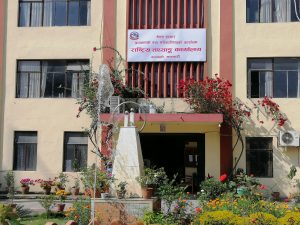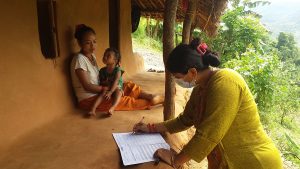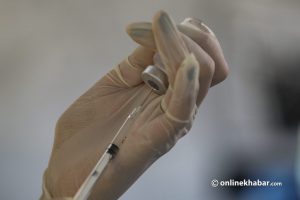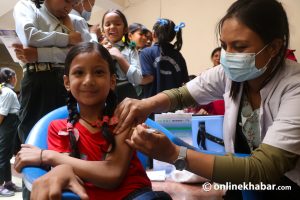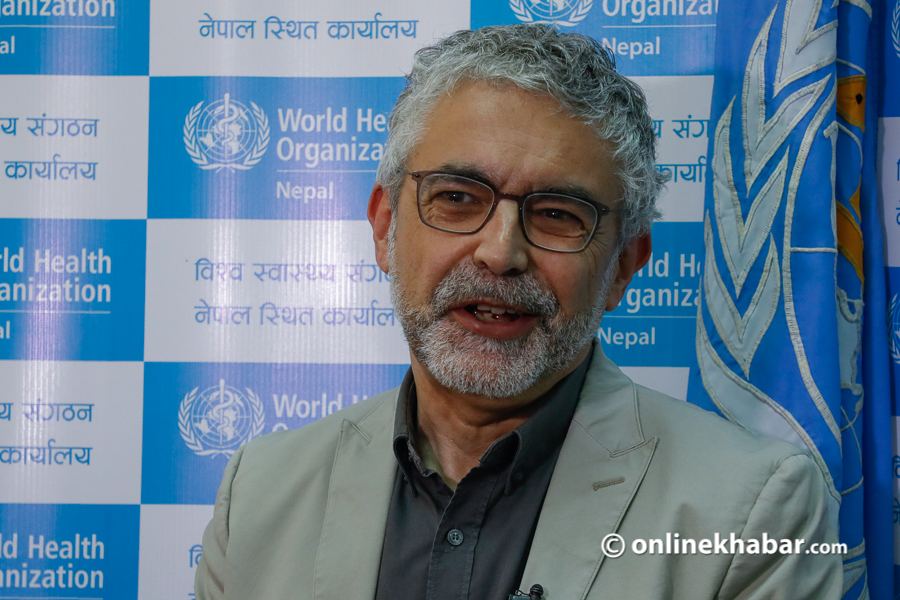 As the world is struggling to combat the Covid-19 spread, the World Health Organisation, the United Nations health agency, is advising the governments worldwide to strengthen their responses. The agency is also working with the government of Nepal, which is widely criticised for slow testing and inefficient response measures. Interestingly, the WHO has not given any public remark about the government’s Covid-19 response and recent protests. When Onlinekhabar interviewed WHO Representative to Nepal Dr Jos Vandelaer Friday, he also sounded more sympathetic than critical towards the government. He said the recent changes introduced by Nepal in its testing strategy had a reason, suggesting the public should also be equally responsible to combat the crisis.
As the world is struggling to combat the Covid-19 spread, the World Health Organisation, the United Nations health agency, is advising the governments worldwide to strengthen their responses. The agency is also working with the government of Nepal, which is widely criticised for slow testing and inefficient response measures. Interestingly, the WHO has not given any public remark about the government’s Covid-19 response and recent protests. When Onlinekhabar interviewed WHO Representative to Nepal Dr Jos Vandelaer Friday, he also sounded more sympathetic than critical towards the government. He said the recent changes introduced by Nepal in its testing strategy had a reason, suggesting the public should also be equally responsible to combat the crisis.
Excerpts:
Let’s begin the conversation with something personal. As a foreigner living in Kathmandu, how do you feel about this pandemic situation?
I have been here in Nepal for five years, but this pandemic has recently changed everybody’s life, including mine. Nepal is a welcoming country; I have been enjoying working here. But, I can see in this situation that many people are fearful; they fear a lot – of the disease. So, my experience has seen differences in the past few months. Of course, the lockdown also changed a lot of things.
Do you ever feel that your life would have been different had you been in some other place right now?
The pandemic has created different situations in different countries. For example, many countries have put in place the lockdown, but the way they have been doing is different from each other. The way people react to lockdown is also different. The counties are in different phases of the pandemic. So, my feeling would have been different if I had been into another country, obviously.
Working as the top WHO official in Kathmandu, how have you assessed the way Nepal has dealt with the pandemic situation? What are Nepal’s strengths, weaknesses, opportunities, and challenges?
In Nepal, the first case was in January and there were not any new cases in the next two months. Very immediately after the second case in March, the government decided to do lockdown. Since then, we have not seen a very wide stretch of community transmission. But, a lot of people have returned to Nepal, particularly from India. Most of them have been quarantined; many of them have also tested positive for coronavirus. The case count as of today, is, by and large, a result of the testing strategy.
Nepal’s situation is special. In other countries, governments test people with symptoms. In Nepal, you cannot do that because there are very few people who have symptoms. Most of the people who have tested positive seem perfectly healthy. The government, accordingly, has adjusted the strategy of testing symptomatic people into looking around where the highest risks would be. It decided to look at the people coming home from India; that is why they found a higher number of cases among them. I think this strategy has worked. That is why, the community transmission has not been seen yet; that may come, but not yet.
But, the big influx of so many people in a short span has created a problem in itself. Quarantining these people in a way that they can keep distance has been difficult; maintaining normal conditions of quarantine has also been difficult.
 Though you think the adjustment to the testing strategy has worked, many experts and members of the public have protested the adjustment. They say abstaining from testing everyone quarantined could increase the risk of community transmission. Do not you think Nepal is moving backwards?
Though you think the adjustment to the testing strategy has worked, many experts and members of the public have protested the adjustment. They say abstaining from testing everyone quarantined could increase the risk of community transmission. Do not you think Nepal is moving backwards?
I do not think Nepal is moving backwards; it is changing its strategy. There is a good reason to do that. With so many people coming in, if you want to test everyone—twice, upon arrival and while leaving the quarantine, you will need a lot of tests. But, we know Nepal’s testing capacity is too low to test thousands and thousands of people crossing the border in one go, though it has improved from the beginning. At the same time, at the global level, we also know that the supplies of testing equipment are in limited quantities. You cannot keep on ordering PCR testing kits as much as you like. You cannot get everything you want. You have to keep that in mind.
The new guideline’s focus on the people with symptoms is certainly the right way to go. It takes a practical approach—let’s test whoever we can with the means whatever we have.
But, there is a big important thing to be said here: all the people coming from India have to be quarantined. You have to keep them in quarantine, and the quarantine has to be up to the good standard so that they do not start infecting each other. High-quality quarantine and less testing during quarantine (should) go hand-in-hand.
But, why do not you think that people leaving the quarantine without a test would carry the virus to the community and infect others?
You can explain like that, but keep in mind when you keep people for two weeks in quarantine, even if they are infected, the virus will have died by two weeks later. Hence, if you send them without a test after a two-week quarantine, you can be certain that they do not have the virus and they will not be able to infect anyone anymore—unless they show the symptoms.
Of course, people with the symptoms are different. They should be taken out of quarantine, tested and isolated. I think that is already happening.
But, you cannot mix different groups in quarantine. For example, if there is a group quarantined, and another group comes in after a few days, you cannot mix them. If you manage the quarantine facilities properly, the chances of having the virus after two weeks (in asymptomatic people) is really low.
So, basically, you mean Nepal now needs to improve the quarantine facilities, not the testing strategy?
Yes. I think this is the next thing to do now. Given the amount of testing that you would need otherwise, that would be a logical thing to do now.
 So how can Nepal improve the quarantine facilities?
So how can Nepal improve the quarantine facilities?
People need to be housed in a way that allows them to stay there for two weeks. You need to have enough space between the people; the beds, for example, should not be close together. You have to ensure that they can keep physical distance when they move together. Using a mask is certainly recommended because the sites are overcrowded. Distribution of food and water, proper sanitation, facilities to wash hands, and medical supervision are important to make sure that quarantine sites are well managed.
But, you know Nepal is in a difficult condition. There are thousands of people coming in, but the government does not have enough money to quarantine them in the way you describe. How can Nepal make a better balance?
I understand it is a difficult balance. It is hard for me to say how to solve that because it is not only a public health issue. But, I think we can still look at how to balance the capacity of quarantine beds available with the number of people coming in. If there are too many people, it is obvious that you cannot ensure up-to-the-standard quarantine facilities for all of them.
Overall, if you were asked to point out three good things that the Nepal government and Nepali people did and their three mistakes?
First of all, the government was quick to test people whom it felt were more at risk. Initially, it did tests in the community, and later with the people coming in from India. The testing capacity was also quickly improved; in the beginning, it might have been on the low side, but over time it increased essentially. Secondly, the lockdown has certainly helped in reducing the spread. It is an inconvenience for all of us; some people were much more affected with income losses. But, it certainly has had an impact on the level of the spread. The third thing—I think the government used the period of lockdown to prepare. A lot of things have happened in preparing Covid-19 hospitals, getting PPE and other equipment, and training hospital staff.
On the negative side, people still have not understood what physical distancing is. If you walk around, you can see that people are still close in groups. But, to protect yourself and others, you need to do your own share. Then, of course, more could have been done. I know there has been much criticism around that. But, you should keep in mind that Nepal is not a rich country; what Nepal can do is not as same as what other richer countries can do. You can also argue that the response could have been faster, and earlier. But, some preparations have happened; some are going on. I hope that things get better and there will be enough capacity to deal with the cases.
Along with the pandemic, the infodemic has also troubled the world. Nepal is also not different. Many people here believe that they have a better immune system. How do you assess its impact on the situation?
Misinformation comes with the change in the media landscape. Social media play a bigger role than they used to and traditional media have also adjusted to the new reality. These days, everybody can put anything on the web without any verification. That happens in every country. In Nepal, they say there is a way of treating cases; they say the virus here is different from other places; people have a stronger capacity. [To cope with this] the WHO at the global level has built alliances with providers of social media content such as Facebook—to check for the false messages so that they are taken off by these platforms. Also, what we have done is providing the verified contents especially for social media, shared through a number of volunteers.
 Do you think the WHO office in Nepal can become more proactive in this front and combat the false information here in the near future?
Do you think the WHO office in Nepal can become more proactive in this front and combat the false information here in the near future?
We work with our partners for that. They monitor social media and work on ensuring that misinformation is reduced.
Moving forward, when do you think Nepal would reach its peak of the infection? Reports say the peak occurs in the third or fourth month in most of the countries. But, can such a trend be generalised in the context of Nepal?
It is impossible to say right now. In Nepal, the curve is going up, but almost all of these cases are among the returnees. So if the government stops everybody from coming in tomorrow, the curve will also stop. That is why we have not seen much evidence of widespread community transmission yet. But, at some point, it is bound to happen because it is happening in every country. So far, the cases are contained in quarantine sites, but they will spread in the community because there is no immunity. Once that happens, the curve will really start going up. But, it is very difficult to predict when that will happen in Nepal, and how high the peak will be.
You also worked with Unicef for many years and are an immunisation expert. How do you evaluate the current pandemic’s impact on children?
We all talk about Covid-19 now and it has occupied our mind. But there are people who fall sick with other diseases and prevention should continue. In Nepal, we understand that essential services including immunisation have continued up to a certain level, but they have also decreased from the past.
Nepal has a strong immunisation programme, and more than 90 per cent of children get immunised. But, with Covid-19, because people cannot move, because health workers are not available, and because the parents are scared of the disease, the coverage has come down. If it continues too long and too deep, there is a risk of spreading measles and so on.
If the pandemic does not last long, the programme can come back quickly because it is robust. When the earthquake hit Nepal in 2015, the immunisation programme was disrupted, but it came back very quickly.
But, what is the risk of Covid-19 itself among children? Some people it is low among children and youth. But, in Nepal, most of the infected are youth.
In the context of Nepal, it is normal. Most of the infected are returnees and most of the people going to work in India are young men between 15 and 45 years. There is no surprise there. But, if you compare to other countries, yes, it does not make any sense. We have a few women among the infected because we know very few women go to work in India.
For the reason that most of the infected people are youth, the death rate has been quite low in Nepal.
Recently, the government has relaxed lockdown restriction measures. Many people fear that the number of cases would go up now dramatically. What do you think about these fears? How can the country overcome them?
The lockdown was put in place to put Covid-19 in check; I think it has been successful in doing that. But, you can keep lockdown in place for a certain period only because it has enormous economic implications. So as in other countries, Nepal also needed to loosen the lockdown even though there are viruses around. But, there are different ways of loosening effectively.
One is: you do not lift the lockdown completely. You do it in stages; that is what the government is doing. You still have some restrictions; the movement is improved; people can start their work again, but not everything. There are some smaller things also. For example, decide how many people go inside a shop.
On the personal side, there are many things we can do now. Keep distance; wear a mask; wash your hands regularly. Do not cough onto people; see a doctor when you fall sick. These are the things we all need to do. But, as I said earlier, in Nepal, it is not yet fully understood. While people are not keeping distance, they are heavily relying on masks. They think wearing a mask guarantees safety, but it is not enough.
So, do you mean it is the public, not the government, that decides the rate of spread?
It is both. Public behaviours certainly have a major impact on how the virus will spread. But, the government also needs to do its part. It needs to continue tests, treat patients when they fall sick.
Finally, some public health stakeholders in Nepal fear that recent adversities between the WHO and the US government could impact the global health agency’s support to Nepal. How likely is the impact?
It is still early to say what the real effects will be. My headquarters is looking into that, also including effects on Nepal.






